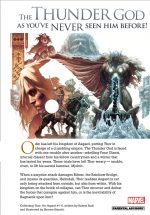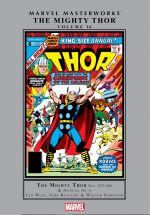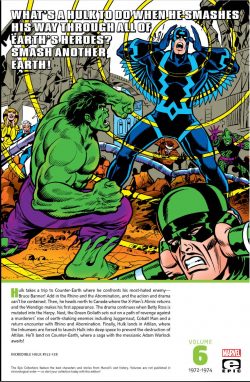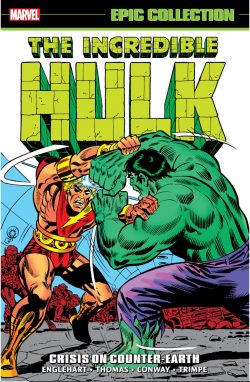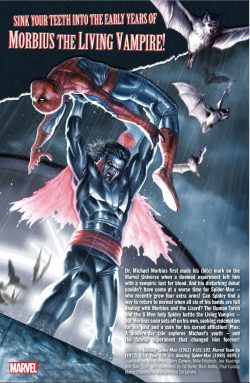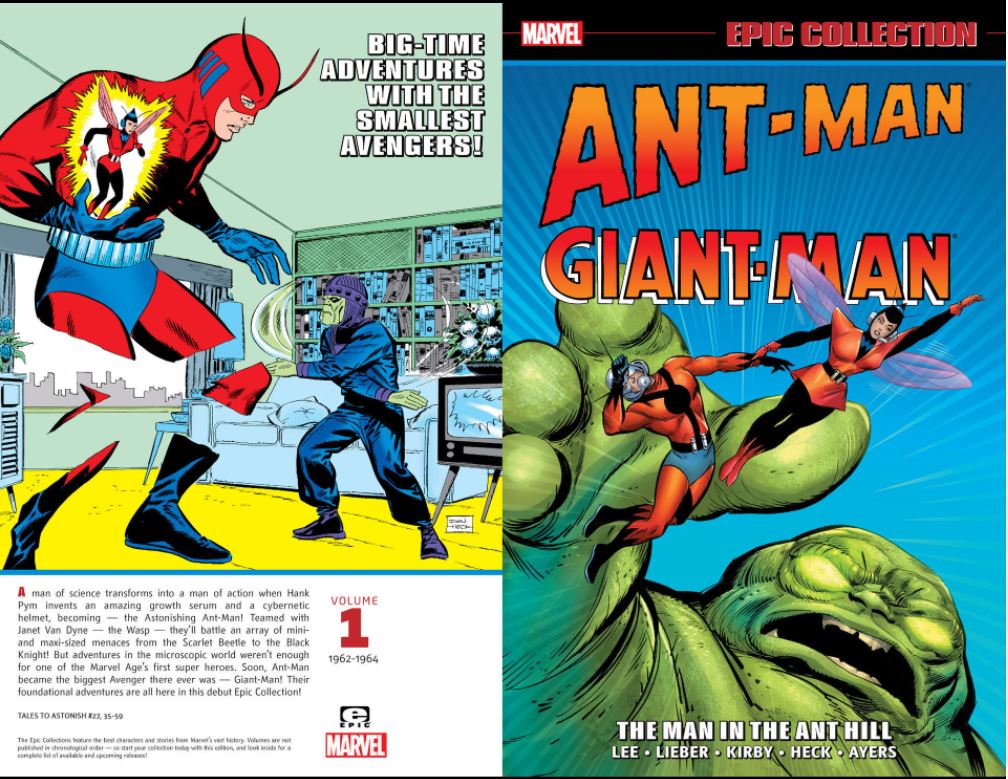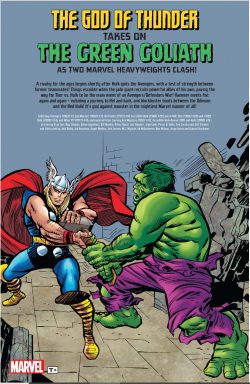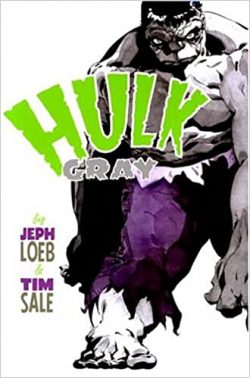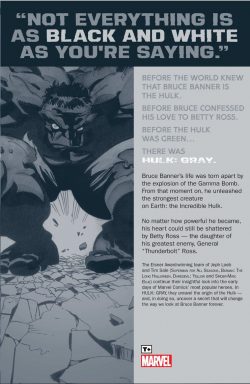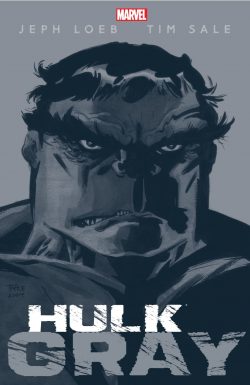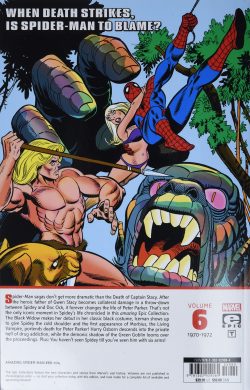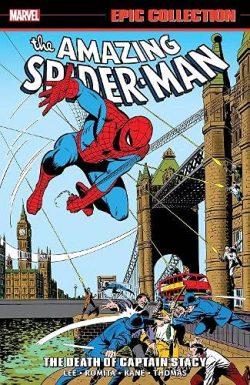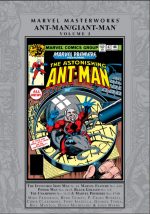
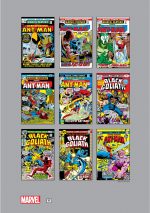
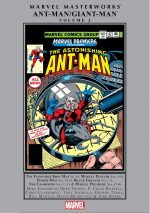
By Roy Thomas, Mike Friedrich, Tony Isabella, Bill Mantlo, Chris Claremont, David Micheline, Herb Trimpe, P. Craig Russell, George Tuska, John Byrne, Ross Andru, Jim Starlin, Ron Wilson, Rich Buckler, Keith Pollard & various (Marvel)
ISBN: 978-1-3029-1079-2 (HB/Digital edition)
Marvel Comics built its fervent fan base through strong and contemporarily relevant stories and striking art, but most importantly by creating a shared continuity that closely followed the characters through not just their own titles but also through many guest appearances in other comics. Such an interweaving meant that even today completists and fans seek out extraneous stories to get a fuller picture of their favourite’s adventures.
In such an environment, series such as these Marvel Masterworks are a priceless resource approaching the status of a public service for collectors, especially when you can now purchase and peruse them electronically from the comfort of your own couch, or the lesser luxury of your parents’ basement, garage or attic…
If you’re of a particularly picky nature – and what comic book superhero fan isn’t? – you could consider the Astonishing Ant-Man to be the second star of the Marvel Age of Comics. The unlikeliest of titans first appeared in Tales to Astonish #27 (cover-dated January 1962, so on sale during the last months of 1961), in one of those splendidly addictive men-vs-monsters anthology titles that dominated in the heady days of Science Fiction Double-Feature B-Movies.
It was intended as nothing more than another here-today, gone-tomorrow filler in one of the company’s madly engaging pre-superhero “monster-magsâ€. However, the character struck a chord with someone since, and as the DC Comics-inspired superhero boom flourished, and Lee sprung The Hulk, Thor and Spider-Man on the unsuspecting kids of America, Pym was economically retooled as a fully-fledged costumed do-gooder for TtA #35 (September 1962).
You can read about his extremely eccentric career elsewhere, but suffice it to say Pym was never settled in his persona: changing name and modus operandi many times before junking his Ant-Man identity for the reasonably more stable and more imposing identity of Yellowjacket…
This episodic, eclectic and entomologically edifying compendium gathers the last full series of the original Ant-Man, plus the legacy of science adventurer Hank Pym as his size-shifting discoveries were employed by other champions. Contained herein are pertinent portions of Invincible Iron Man #44; Marvel Feature #4-10; Power Man #24-25; Black Goliath #1-5, The Champions #11-13 and Marvel Premiere #47-48, convolutedly spanning January 1972 to June 1979.
There are three heroes on offer here and each comes with an Introduction by his key scripter: Mick Friedrich’s ‘Downsizing Hank Pym’; ‘Professor Bill’s Big Adventure‘ by Tony Isabella and David Micheline’s ‘New Kid on the Block’, all sharing insights and reminiscences to delight every true ant-ficionado (yes. I said that, and I’m not sorry!)
The ball starts rolling with a brief back-up vignette from Invincible Iron Man #44 as Roy Thomas, Ross Andru & Mike Esposito light-heartedly deliver ‘Armageddon on Avenue ‘A” as Ant-Man Pym clashes again with the sinister Scarlet Beetle. The evil arthropod stills seeks to eradicate mankind, but is too busy battling Pym to notice his new secret citadel catching alight as part of a seedy insurance scam. Bah! Human scum!
Marvel Feature #4 then begins a new series with ‘The Incredible Shrinking Doom!’ (by Friedrich & Herb Trimpe) as a hero history recap segues into ‘The Beginning’ with Peter Parker interviewing Dr Pym before they team up to rescue a kidnapped boy. The son of Curt Conners (The Lizard) has been snatched to force the surrender of a valuable formula. However, while cleaning up M’Sieu Tête‘s thugs, Pym is injected with a bacterial enzyme that traps him at the size of an insect and even Spider-Man cannot help him…
The saga proceeds in #5’s ‘Fear’s the Way He Dies!’ as arch enemy Egghead returns even as Ant-Man loses all the precious technology that bolsters his powers. Deprived of his insect-controlling cybernetic helmet, Pym is helpless until the maniac’s niece Trixie Starr makes him new duds. It’s not quite enough to defeat the villain, but at least the shattering explosion of his mobile HQ seems to drive the killer away…
Pym’s wife Janet resurfaces in Marvel Feature #6’s ‘Hellstorm!’ (inked by Mike Trimpe) as the beleaguered hero – thanks to trusty pet hound Orkie the dog – finally reaches his own home only to be attacked by another old foe… Whirlwind. In the aftermath the house is totally destroyed and Mr & Mrs Pym are officially declared dead…
P. Craig Russell, Dan Adkins & Mark Kersey illustrate ‘Paranoia is the Para-Man!’ in #7 as a new android enemy captures Hank and Jan. escape and the mechanoid’s defeat mutates the Wasp into a true insectoid predator for #8’s deadline wracked ‘Prelude to Disaster!’ Russell, Jim Starlin & Jimmy Janes’ framing sequence here originally supported a Lee, Kirby & Don Heck origin flashback but you can just consult the first volume in this series if you’re feeling a little completist…
Here and now, however, Marvel Feature #9 ‘…The Killer is My Wife!’ – limned by Russell & Frank Bolle – finally finds Hank battling his mutated killer wife as Pym’s lab partner Bill Foster and Iron Man investigate their “deaths.†Tragically, not so far from them, the tiny terror is overwhelmed and temporarily cured by her husband, just in time for both to fall victim to new nutcase Doctor Nemesis, before the saga and the series are hastily wrapped up in concluding chapter ‘Ant-Man No More!‘ by Friedrich, Russell & Frank Chiaramonte.
Ant-Man faded from view, eventually replaced by Yellowjacket again, and one among many in the Avengers.
Time passed and a new writer decided it was time to try the size-shifting concept again. It began as so often with a try-out taster in an already established title…
While hiding in plain sight as a Hero for Hire in Times Square, escaped convict Luke Cage fell in love with doctor Claire Temple. When she abruptly vanished, Cage and buddy D.W. Griffiths scoured America looking for her. The trek fed directly into a 2-part premier for another African American superhero with the trail leading to the Ringmaster’s Circus of Crime in Power Man #24 (January 1975) where ‘Among Us Walks… a Black Goliath!’ by Tony Isabella, George Tuska & Dave Hunt.
One of the earliest returning black characters in Marvel’s comics, the above-mentioned Bill Foster was a highly educated biochemist working for Tony Stark and with Henry Pym. Foster first appeared in Avengers #32 (September 1966), working to find a cure when – as Goliath – Pym was trapped at a 10-foot height. Foster faded from view when Pym eventually regained his size-changing abilities…
Having continued his own experiments in size-shifting, Foster was now trapped as a freakish colossus, unable to shrink to human proportions. Cage painfully learned he was also Claire’s former husband and when he became trapped at 15 feet, she had rushed back to Bill’s substantial side to help find a cure.
After Luke turns up, passions are stoked, resulting in another classic heroes-clash moment until the mesmeric Ringmaster hypnotises all combatants, intent on using their strength to feather his own three-ring nest. ‘Crime and Circuses’ (Isabella, Bill Mantlo, Ron Wilson & Fred Kida) sees the heroes helpless until Claire comes to the rescue, before making her choice and returning to New York with Luke. Foster soon gravitated to his own short-run series, becoming Marvel’s fourth African American costumed hero under a heavy-handed and rather uninspired sobriquet…
Cover-dated February 1976, and courtesy of Isabella, Tuska & Vince Colletta, Black Goliath #1 reintroduced a far more together hero. Foster was now in complete control of his powers and led an exotic, eccentric Stark International Think Tank in Los Angeles. Sadly, his arrival coincided with a spate of high tech burglaries that revealed how out-of-depth ‘Black Goliath!’ was when the gang boss was exposed as living nuclear nightmare Atom-Smasher, who doled out ‘White Fire, Atomic Death!’ in #2 as scripter Chris Claremont joined Tuska & Colletta.
Barely surviving the first assault, Foster brought in his team of maverick geniuses for the second and decisive round, blissfully unaware the thermonuclear thug was working for a hidden mastermind…
‘Dance to the Murder!’ in #3 offers partial explanations as mystery man Vulcan leads multiple attacks on the Think Tank in an effort to liberate an enigmatic alien artefact. The result is chaos and catastrophe, exacerbated in #4 when ‘Enter Stilt-Man …Exit Black Goliath!’ – with art from Rich Buckler & Don Heck – finds the hero distracted by a supervillain hungry to upgrade his powers and status, and the mystery box swiped from the rubble by a looter…
The series came to an abrupt halt with #5 (November 1976), with Keith Pollard illustrating a tale of ‘Survival!’ as Foster and two bystanders are exiled on a lethal alien planet. Meanwhile on Earth, the Box is beginning to awaken…
The storyline was completed in LA based team title The Champions where #11 (February 1977) opened proceedings with ‘The Shadow from the Stars’ by Mantlo, John Byrne & Bob Layton. Returned without explanation, Foster was building tech for the team (Black Widow, Angel, Iceman, Hercules, Ghost Rider and Dark Star) as a side bar to the main event wherein Hawkeye and Two Gun Kid call for help to repel an alien incursion by vintage villain and sentient shadow Warlord Kaa…
Back to the plot for #12, ‘Did Someone say… the Stranger?’ sees Black Goliath ambushed by Stilt-Man as the long-contested Box begins to activate. When universal Elder The Stranger comes to reclaim his planet-destroying Null-Life Bomb, he deems it too late once the device warps reality and dumps the Champions in the realm of former Thor foe Kamo Tharnn, leaving Foster on Earth to prevent ‘The Doom That Went on Forever!’
Foster again faded from sight until revived for 1980s classic the Project Pegasus Saga, where he reclaimed the name Giant-Man, but this collection concludes with arguably the most successful size-shifting centurion: solo superhero, Avenger, entrepreneur, comedy turn and screen superstar Scott Lang… a true legacy hero made good.
Comics creators are six parts meddler and five parts chronic nostalgia buff and eventually somebody convinced somebody else that the concept and property of Ant-Man could be viable again, so we end here with the introduction of reformed thief Lang who debuted in Marvel Premiere #47 (cover-dated April 1979).
Those first somebodies were David Michelinie, John Byrne & Bob Layton who produced ‘To Steal an Ant-Man!’, revealing how a former electronics engineer had turned to crime – more out of boredom than necessity – and, after being caught and serving his time, joined Stark International as a resolutely reformed character. However, when his daughter Cassie developed a heart condition that wiped out his savings, Scott reverted to old ways to save her…
Desperate to find the wherewithal to hire experimental surgeon Dr. Erica Sondheim, he begins casing likely prospects, but is shattered when Sondheim is abducted by psychotic industrialist Darren Cross. The magnate is already using all the resources – legal and otherwise – of his mega-corporation Cross Technological Enterprises to keep himself alive…
Needing cash just to broach the CTE complex, Lang goes back to Plan A, burgling the lab of retired superhero Henry Pym and discovers mothballed Ant-Man gear and size-changing gases. In a moment of madness, Lang decides not to sell the stolen tech but instead use it to break into Cross’ citadel and rescue Sondheim…
That plan doesn’t go so great either, as Lang discovers the dying billionaire – in a desperate attempt to stay alive – has been harvesting the hearts of homeless people to power an experimental device which has mutated him into a monstrous brute…
After learning with horror ‘The Price of a Heart!’ (June 1979), Lang eventually triumphs; unaware until the very last that Pym had allowed him to take the suit and was backstopping him every inch of the way. With Cassie saved, Yellowjacket then invites Lang to continue as the new Ant-Man…
And so it begins again…
Completing this triptych treat are extras including original art pages by Trimpe; pencil art and the unused ending to Marvel Feature #10 by Russell (compared in situ with what actually got published as the series was rapidly concluded); two unused covers to Marvel Premiere #48 (by Layton), biographies of all concerned and peppered throughout with rousing covers by Gil Kane, Frank Giacoia, Joe Sinnott, Trimpe, Starlin, John Romita & Sal Buscema, Russell & Adkins, Rich Buckler, Jack Kirby, Al Milgrom, Layton, Dave Cockrum and Bob McLeod.
These itty-bitty sagas range from lost gems to true classics and will delight Marvel Movie buffs as well as the redoubtable ranks of dedicated comic book readers all cheerfully celebrating Pym’s 60 years of service and inspiration.
© 2018 Marvel Characters, Inc. All rights reserved.

